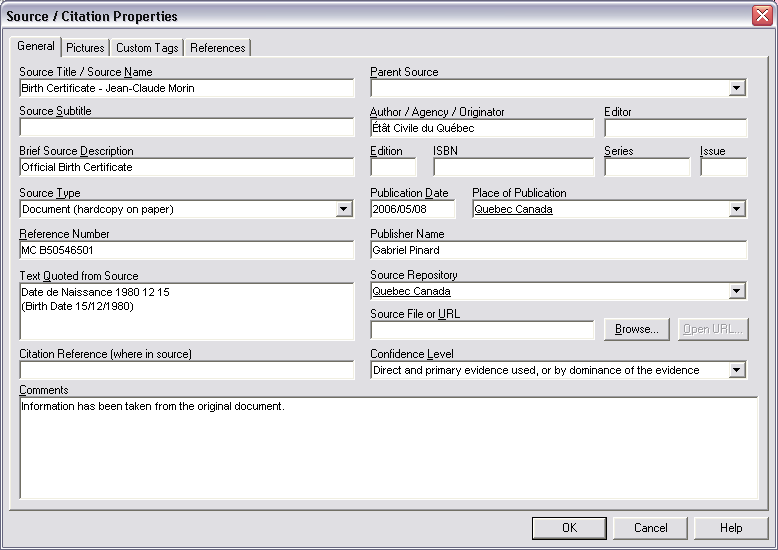 Sources
and References Sources
and References
Sources are very important in genealogy, as they document where the
information comes from. At first, it may seem like extra work to enter this
data, but it can prove to be very important. Not only can the information be
useful for other genealogists interested in knowing where the information
came from, but it can also be very useful if data conflicts occur later, or
if you need to look back at the original record for additional information
about the individual or the event.
GenoPro supports sources in a unique way: whether it is a book, a newspaper,
a citation or a birth record, all information is stored as a source.
| | | |
 The same source can be used by multiple individuals, unions or places without having to duplicate the information. If a source is updated or completed later, all objects referencing to this
source will be updated. The same source can be used by multiple individuals, unions or places without having to duplicate the information. If a source is updated or completed later, all objects referencing to this
source will be updated. | | | | |
The first step to enter a source
is to find the Sources tab.

Individual Properties - Source Tab
This tab shows only the most popular fields of a source. To view all
fields click on the [Edit] button. Another dialog will appear with
all fields related to a source. This dialog also has tabs to add
pictures and custom tags to the source
information.

Source Dialog Example
| | | |
 In GenoPro, Sources and Citations are merged together. In fact, sources are generic, so not all information fields necessarily apply to your source; just leave them empty. In GenoPro, Sources and Citations are merged together. In fact, sources are generic, so not all information fields necessarily apply to your source; just leave them empty. | | | | |
Source Title / Source Name
Name by which the source or citation is known. This field must be very
complete and representative of the source because the value is used in the
source pick list everywhere.
Source Subtitle
A subtitle is tacked onto a title to clarify the meaning of the title.
Sometimes the title as written is purposefully obscure; the subtitle in this
case indicates the source's real content.
Brief Source Description
A brief description of the source or citation. This field is rarely used,
but it may be needed if the title and subtitle are not descriptive enough.
Source Type
The source type is used to classified the type of source information you
have. The list offers a wide variety, but if your source type is not in the
list, pick the closest type or leave it blank and specify its description in
the comments section.
The possible values are: Audio, Book, Card, CD, Deed, DVD, Electronic
File, Email, Fiche, Film, Interview, Magazine, Manuscript, Map, Newspaper,
Photo, Tombstone / Gravestone, Video or Website / URL.
Reference Number
Source unique identifier according to its type (e.g.: birth certificate
reference number).
Text Quote From the Source
An exact copy of the relevant information in the source. This is
particularly important if the source text is long or if the source is an
image.
Citation Reference (where in the source)
The location of the citation in the source. This can be indicated with the
page number or the reference point (heading, 2nd paragraph) of the citation
in the document.
Parent Source
Sources can be hierarchical. For instance, a newspaper could be a source,
and an article could be a source that has the newspaper itself as a parent
source. This is a way to structure the information so that you can easily
find related sources to that particular newspaper.
| | | |
 Using parent sources saves time because when you pick a parent source,
all fields of the parent source are "copied" to your source. Using parent sources saves time because when you pick a parent source,
all fields of the parent source are "copied" to your source. | | | | |
Author / Agency / Originator
The person, agency, or entity who created the record. For a published work,
this could be the author, compiler, transcriber, abstractor, or editor. For
an unpublished source, this may be an individual, a government agency, a
church organization, a private organization, etc.
Editor
Person responsible for the editorial aspect of the publication.
Edition
Often used by magazines or newspapers, refers to a different version of the
title.
ISBN
International Standard Book Number - a unique ten-digit identifier for each
published title.
Series
Often used by magazines, it refers to the collective title applied to the
group as a whole, given in addition to individual proper titles.
Issue
Often used by periodicals and newspapers, it refers to the number
identifying the issue of the series publication to which it belongs.
Publication Date
Date when the source was published or otherwise made available for release.
Place of Publication
Place (city) where the source was published or released. 
Publisher Name
The name of the publication house.
Source Repository
Repository where the source is located. A repository is where a source
might be stored or archived, such as a church or a library.

Source File or URL
The link to the original information, the file name or the Web page.
Confidence Level
Defines how accurate the sources or citations are.
Comment
Insert additional information related to the source or the citation.
|